Class 10 Science Chapter 15 Our Environment NCERT Solutions
Before getting into the details of our environment class 10 extra questions and answers, let’s have an overview of topics and subtopics under Class 10 Science Chapter 15 Our Environment:
- Our Environment
- Eco-System — What Are Its Components?
- How Do Our Activities Affect The Environment?
NCERT Solutions for Class 10 Science Chapter 15 Intext Questions
Page Number: 260
Question 1
What are trophic levels ? Give an example of food chain and state the different trophic levels in it.
Answer:
Trophic Levels : The various steps in a food chain at which the transfer of food (or energy) takes place are called trophic levels.
Example : A food chain operating in a grassland is given below :
Grass → Insects → Frog → Birds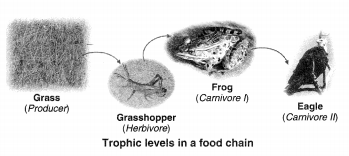
In this food chain
- Grass represents first trophic level.
- Grasshopper represents second trophic level.
- Frog represents third trophic level.
- Eagle represents fourth tropic level.
Question 2
What is the role of decomposers in the ecosystem ?
Answer:
(i) Decomposers help in decomposing the dead bodies of plants and animals and hence act as cleansing agents of the environment.
(ii) Decomposers also help in putting back the various elements of which dead plants and animals are made, back into the soil, air and water for reuse by the producers like crop plants.
(iii) They help in recycling of the nutrients.
(iv) They decompose dead remains thereby providing space for new life to settle in the biosphere.
Page Number: 262
Question 1
Why are some substances biodegradable and some non-biodegradable ?
Answer:
The microorganism like bacteria and other decomposer organisms (called saprophytes) present in our environment are specific in their action. They break down the materials or products made from natural materials (say, paper) but do not break down man-made materials such as plastics. So, it is due to the property of decomposer organisms of being specific in their action that some waste materials are biodegradable, whereas others are non-biodegradable.
Question 2
Give any two ways in which biodegradable substances would affect the environment.
Answer:
(i) Biodegradable substances are decomposed by the action of microorganisms and decomposed materials are recycled through geo-chemical cycle.
(ii) These substances keep the environment clean.
Question 3
Give any two ways in which non-biodegradable substances would effect the environment.
Answer:
(i) They cause air, water and soil pollution.
(ii) They may cause bio-magnification in the food chain and end up in humans.
Page Number: 264
Question 1
What is ozone and how does it affect any ecosystem ?
Answer:
Ozone (O3) is an isotope of oxygen, i.e., it is a molecule formed by three atoms of oxygen.
At the higher levels of the atmosphere, ozone performs an essential function. It shields the surface of the earth from ultraviolet (UV) radiations from the sun. These radiations are highly damaging to organisms. Ultraviolet rays can cause skin cancer.
Question 2
How can you help in reducing the problem of waste disposal ? Give any two methods.
Answer:
(i) Recycling : The solid wastes like paper, plastics and metals, etc. are recycled.
(ii) Preparation of Compost: Biodegradable domestic wastes such as left over food, fruit and vegetable peels and leaves of potted plants, etc. can be converted into compost by burying in a pit dug into ground.
NCERT Solutions for Class 10 Science Chapter 15 Textbook Chapter End Questions
Question 1
Which of the following groups contain only biodegradable item ?
(a) Grass, flowers and leather
(b) Grass, wood and plastic
(c) Fruit peels, cake and lime juice
(d) Cake, wood and grass
Answer:
(a) Grass, flowers and leather.
Question 2
Which of the following constitutes a food-chain ?
(a) Grass, wheat and mango
(b) Grass, goat and human
(c) Goat, cow and elephant
(d) Grass, fish and goat
Answer:
(b) Grass, goat and human.
Question 3
Which of the following are environment friendly practices ?
(a) Carrying cloth-bags to put purchases in while shopping
(b) Switching off unnecessary lights and fans
(c) Walking to school instead of getting your mother to drop on her scooter
(d) All of the above
Answer:
(d) All of the above.
Question 4
What will happen if we kill all the organisms in one trophic level ?
Answer:
The food chain would end and ecological balance would be affected.
- If the herbivores are killed, then the carnivores would not be able to get food and would die.
- If carnivores are killed, then the population of herbivores would increase to unsustainable level.
- If producers are killed, then the nutrient cycle in that area would not be completed.
Question 5
Will the impact of removing all the organisms in a trophic level be different for different trophic levels ? Can the organisms of any trophic level be removed without causing any damage to the ecosystem ?
Answer:
Yes, the impact of removing all the organisms in a trophic level will be different for different trophic levels. For example, on removing producers; herbivores would not be able to survive or they would migrate and ecosystem would collapse. If herbivores are removed, producers would grow unchecked and carnivores would not get food. If carnivores are removed, herbivores would increase to unsustainable levels and could destroy the producers. If decomposers are removed, the dead animals would pile up due to which the environment would become polluted. In addition to this, if dead animals will not decompose, the recycling of nutrients in the soil will be stopped and its fertility will be reduced. As a result the green cover of the earth will be lost. Thus to maintain the balance of the ecosystem the presence of organisms is necessary at each trophic level.
Question 6
What is biological magnification ? Will the levels of this magnification be different at different levels of the ecosystem ?
Answer:
Biological magnification : The increase in concentration of harmful chemical substances like pesticides in the body of living organisms at each trophic level of a food chain is called biological magnification.
Yes, levels of bio-magnification would increase as the trophic level increases and would be the highest for topmost trophic level. It would affect their biological process such as growth, reproduction, etc.
Question 7
What are the problems caused by the non-biodegradable wastes that we generate ?
Answer:
The problems caused by the non-biodegradable wastes are :
- If the quantity of non-biodegradable matter increases in the nature then bio-magnification of poisonous chemicals in our body increases.
- If the non-biodegradal waste keeps on increasing there will not be left any substance for new organisms.
- The increasing quantity of non-biodegradable waste will cause imbalance of ecosystem.
Question 8
If all the waste we generate is biodegradable, will this have no impact on the environment ? [CBSE 2011, 2013]
Answer:
If all the waste we generate is biodegradable, it will also have impact on the environment. If it is disposed off properly, the problem of air, water and soil pollution can be lessened to an extent. There would be less health problems and humans would be disease-free.
But if it is not disposed off properly, it will affect the environment adversely.
Question 9
Why is damage to the ozone layer a cause for concern ? What steps are being taken to limit this damage ?
Answer:
The damage to the ozone layer is a cause for concern because if the ozone layer in the atmosphere disappears completely, then all the extremely harmful ultraviolet radiations coming from the sun would reach the earth. These ultraviolet radiations would cause skin cancer and other ailments in men and animals and also damage the plants.
In an attempt to protect the ozone layer, the United Nations Environment Programme (UNEP) unanimously forged an agreement among its member countries to freeze CFC production at 1986 levels.
NCERT Solutions for Class 10 Science Chapter 15 Our Environment
Our environment: Eco-system, Environmental problems, Ozone depletion, waste production and their solutions. Biodegradable and non-biodegradable substances.
| Board | CBSE |
| Textbook | NCERT |
| Class | Class 10 |
| Subject | Science |
| Chapter | Chapter 15 |
| Chapter Name | Our Environment |
| Number of Questions Solved | 16 |
| Category | NCERT Solutions |
Page 257
Question 1.
Why are some substances biodegradable and some non-biodegradable ?
Answer:
Substances that are broken down by biological processes are said to be biodegradable. In our environment, many of the substances are broken easily by decomposers (bacteria and fungi) as they possess specific enzymes for such activity. However, there are other substances also which are not broken down in this manner and are known as non-biodegradable substances. Since these substances are not degraded by bacteria and fungi, so they persist for a long time. These non-biodegradable substances will be acted upon by physical processes like heat and pressure.
Question 2.
Give any two ways in which biodegradable substances would affect the environment.
Answer:
- They may produce foul smell during decomposition process.
- They may produce some harmful gases such as ammonia, methane, carbon dioxide, etc., which can further-cause global warming.
Question 3.
Give any two ways in which non-biodegradable substances would affect the environment.
Answer:
- These inert substances simply persist in the environment. This means that these substances require land area for dumping.
- Excess of fertilizers, pesticides and other chemicals changes soil chemistry and also affects aquatic life.
- Most of these chemicals and heavy metal are easily absorbed by the organisms. This causes biological magnification.
Page : 261
Question 1.
What are trophic levels? Give an example of a food chain and state the different trophic levels in it.
Answer:
Each step or level of the food chain forms a trophic level. Consider the following food chain:
Question 2.
What is the role of decomposers in the ecosystem?
Answer:
Role of decomposers in the ecosystem :
- They help in breaking down the complex organic into simple inorganic that go into the soil and are used up by the plants.
- They the nutrient pool of the putting In this way, ad as cleansing agents of nature.
- They help in maintaining the fertility of by adding humus content to it.
Page : 264
Question 1.
What is ozone and how does it affect any ecosystem?
Answer:
Ozone (O3) is a molecule formed by three atoms of oxygen. At the higher of the atmosphere, it shields the surface of the earth from ultraviolet (UV) radiation from the Sun. It may affect any ecosystem in the following ways :
- At the surface of the earth, it is a deadly poison for all lower forms of life.
- If this layer gets depleted, then it may cause cancer in human beings including other plants and animals.
Question 2.
How can you help in reducing the problem of waste disposal? Give any two methods?
Answer:
- By changing our lifestyle and change in attitude will reduce disposable waste.
- Reducing packaging.
- Recycling of waste.
- Preparing compost of biodegradable waste.
Excercise:
Question 1.
Which of the following groups contain only biodegradable items?
(a) Grass, flowers and leather
(b) Grass, wood and plastic
(c) Fruit-peels, cake and lime-juice
(d) Cake, wood and grass
Answer:
(c) Fruit-peels, cake and lime-juice and (d) Cake, wood and grass
Question 2.
Which of the following constitute a food-chain?
(a) Grass, wheat and mango
(b) Grass, goat and human
(c) Goat, cow and elephant
(d) Grass, fish and goat
Answer:
(b) Grass, goat and human
Question 3.
Which of the following are environment-friendly practices?
(a) Carrying cloth-bags to put purchases in while shopping
(b) Switching off unnecessary lights and fans
(c) Walking to school instead of getting your mother to drop you on her scooter
(d) All of the above
Answer:
(d) All of the above
Question 4.
What will happen if we kill all the organisms in one trophic level?
Answer:
If we kill all the organisms in one trophic level, then transfer of energy as well as matter to next higher level will stop. It will lead to over- population at one particular level causing amongst the individuals. This would seriously disturb the food chain and can cause the collapse of an ecosystem even.
Question 5.
Will the impact of removing all the organisms in a trophic level be different for different trophic levels? Can the organisms of any trophic level be removed without causing any damage to the ecosystem?
Answer:
Yes, the impact Of removing all the Organisms in a trophic level will be different for different trophic levels. It will not be possible to remove any organism in any trophic level without causing damage to the ecosystem.
Question 6.
What is biological magnification? Will the levels of this magnification be different at different levels of the ecosystem?
Answer:
The accumulation of harmful chemicals in the body of living organisms at different trophic levels in a food chain is called biological magnification. Yes, the concentration of these harmful chemicals will be different at different trophic levels. It will be maximum at the last trophic levels which is mostly of the top carnivores (quaternary consumers).
Question 7.
What are the problems caused by the non-biodegradable wastes that we generate?
Answer:
(i) Non-biodegradable wastes persist in the environment for a long time and cause greater harm to the various members of the ecosystem by causing biological magnification.
(ii) Non-biodegradable waste such as fertilizers, pesticides, weedicides, etc., changes the soil chemistry. in turn affects the fertility of soil and subsequently reduces the crop yield.
Question 8.
If all the waste we generate is biodegradable, will this have no impact on the environment?
Answer:
Biodegradable waste will be recycled easily by the decomposers such as bacteria and fungi. It will have only this bad impact on our environment that, many Of the gases released during decomposition process may result in global warming.
Question 9.
Why is damage to the ozone layer a cause for concern? What steps are being taken to limit this damage?
Answer:
The ozone shields the surface of the earth from ultraviolet (UV) radiation from the sun. These radiations are highly damaging as they can cause cancer in both plants and animals, damage to eyes and immune system. They can also lead to variations in global rainfall, ecological disturbances and dwindling of global food supplies. Due to these reasons, damage to the ozone layer is a major cause for concern.
Steps which are taken to limit this damage :
- To decrease the use of synthetic chemicals like chlorofluorocarbons (CFCs) which are used as refrigerants and in fire extinguishers.
- In 1987, the United Nations Environment Programme (UNEP) succeeded in reaching an agreement to freeze CFC production at 1986
Multiple Choice Questions (MCQs) [1 Mark each]
Question 1.
Identify the original source of the energy which flows through a food chain?
(a) Carbon dioxide
(b) Glucose
(c) Oxygen
(d) Sunlight
Answer:
(d) All the living organisms get energy directly or indirectly from the sunlight reaching the surface of Earth.
Question 2.
A teacher draws the pyramid of energy on board and writes A, B, C and D, in each trophic level as shown in the diagram given alongside. Which level represents the herbivores?
(a) A
(b) B
(c) C
(d) D
Answer:
(c) The trophic levels represent the transfer of food or energy through various steps or levels in the food chain. Producers harness the maximum energy followed by primary consumers, i.e. a herbivore, which is represented by C in thg given diagram.
Question 3.
Which of the following groups contains only biodegradable items? [NCERT]
(a) Grass, flowers and leather
(b) Grass, wood and plastic
(c) Fruit-peels, cake and lime-juice
(d) Cake, wood and grass
Answer:
(a), (c) and (d) substances that are broken down (decomposed) by the biological processes are said to be biodegradable e.g. fruit-peels, cake, lime-juice, wood, grass, leather, flowers, etc.
Question 4.
Which of the following constitutes a food-chain? [NCERT]
(a) Grass, wheat and mango
(b) Grass, goat and human
(c) Goat, cow and elephant
(d) Grass, fish and goat
Answer:
(b) Each step of food chain form a trophic level. Producers (grass) forms the first trophic level, herbivore (goat) the second and carnivore (human) the third trophic level.
Question 5.
Which of the following are environment- friendly practices? [NCERT]
(a) Carrying cloth-bags to put purchases ‘ while shopping .
(b) Switching off unnecessary light and fans
(c) Walking to school instead of getting your mother to drop you on her scooter
(d) All of the above
Answer:
(d) Cloth-bags are biodegradable, switching off unnecessary light and fans conserves electricity and limited use of petrol/diesel causes less pollution. Hence, all these practices are considered as environment friendly.
Question 6.
Which of the following statements about food chain are correct?
(a) It includes repeated eating, i.e. each group eats the other and is subsequently eaten by some other group of organisms.
(b) It shows a series of branching lines and unidirectional flow of energy.
(c) It shows the unidirectional flow of energy and proceeds in a progressive straight line.
(d) Both (a) and (c)
Answer:
(d) A food chain is a series of organisms in an environment through which energy transfer occurs starting with a producer. It proceeds in straight line. Food chain does not consist of branching lines.
Question 7.
In class, the teacher explained the concept of food chain and energy flow. She made a diagram as given below and asked the students to identify the producer organism in the chain. What do you think will be the student’s answer?
Answer:
(b) Cabbage is the producer component of this chain. It produces food using sunlight and other components by photosynthesis process. Others are all consumers.
Question 8.
An ecosystem includes
(a) all living organisms
(b) non-living objects ,
(c) both living organisms and non-living objects
(d) sometimes living organisms and sometimes non-living objects
Answer:
(c) All the interacting organisms in an area taken together with the non-living constituents of the environment form an ecosystem. Thus, an ecosystem consists of biotic components including all living organisms and abiotic components constituting physical factors like temperature, rainfall, wind, soil and minerals.
Question 9.
In the following groups of materials, which group (s) contains only non-biodegradable items?
(i) Wood, paper, leather
(ii) Polythene, detergent, PVC
(iii) Plastic, detergent, grass
(iv) Plastic, bakelitC DDT
(a) (iii)
(b) (iv)
(c) (i) and (iii)
(d) (ii) and (iv)
Answer:
(d) Substances that cannot be broken down by biological processes in nature are non-biodegradable. e.g. polythene, detergent, PVC, plastics, bakelite, DDT, etc. On the other hand, substances that are broken down (decomposed) by biological processes are said to be biodegradable, e.g. wood, paper, leather, grass, animal bones, etc.
Question 10.
Which of the following statement is incorrect?
(a) All green plants and blue-green algae are producers.
(b) Green plants get their food from organic compounds.
(c) Producers prepare their own food from inorganic compounds.
(d) Plants convert solar energy into chemical energy.
Answer:
(b) Green plants prepare their food from inorganic compounds using radiant energy of the sun in the presence of chlorophyll. All green plants and blue-green algae are called producers as they can prepare food from inorganic substances by photosynthesis. Producers capture the solar energy and convert it into chemical energy.
Question 11.
What will happen if deer is missing in the food chain given below?
Grass → Deer → Tiger
(a) The population of tiger increases.
(b) The population of grass decreases.
(c) Tiger will start eating grass.
(d) The population of tiger decreases and the population of grass increases.
Answer:
(d) If deer is missing in the given food chain, there will not be sufficient food for the tigers. Some of the tigers will die because of starvation and hence, the population of tigers will decrease. Since, grass is eaten by deers, the population of grass will also increase whefl deer is missing.
Question 12.
In a class activity, two students were asked to collect different items from their fellow mates and classify them as biodegradable and non- biodegradable. All the items have been identified except three. Find out which one is non-biodegradable among these?
(a) Jute crafted bag
(b) A sharpner
(c) Empty fevistick
(d) Both (b) and (c)
Answer:
(d) Both (b) and (c), i.e. the sharpener and the empty fevistick container. These products are made from plastic and hence are non-biodegradable.
Question 13.
The diagram shows excretory losses from a rat to the environment.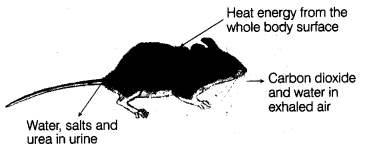
Which of the following will not be returned to the ecosystem and recycled?
(a) carbon dioxide
(b) heat energy
(c) salts
(d) urea
Answer:
(b) Heat energy cannot be recycled, it gets lost in the environment. The generated is returned through the carbon cycle. Salts are used by living organisms present in the ecosystem. Urea also returns to the nitrogen cycle.
Question 14.
Which of the following limits the number of trophic levels in a food chain?
(a) Decrease in energy at higher trophic levels
(b) Deficient food supply
(c) Polluted air
(d) Water
Answer:
(a) Decrease in energy at higher trophic levels limits the number of trophic levels in a food chain. At each trophic level, a large portion of energy is utilised for the maintenance of organisms that occur at that trophic level. So, organisms at higher level gets less and less energy at successive levels. The. number of trophic levels are limited to 3-4 because after that, the energy available for the next level will be too small, i.e. it will be insufficient to sustain life of the organisms.
Question 15.
If a grasshopper is eaten by a frog, then the energy transfer will be from
(a) producer to decomposer
(b) producer to primary consumer
(c) primary consumer to secondary consumer
(d) secondary consumer to primary consumer
Answer:
(c) In a food chain, if a grasshopper is eaten by a frog, then the energy transfer will be from primary consumer to secondary consumer. Grasshopper feeds on producers i.e. the grass/plants. So, it occupies the level of primary consumer. Frogs, eating grasshopper thus become the secondary consumer.
Question 16.
In the given food chain, suppose the amount of energy at fourth trophic level is 5 kJ, what will be the energy available at the producer level?
Grass → Grasshopper → Frog → Snake → Hawk
(a) 5 kJ
(b) 50 kJ
(c) 500 kJ
(d) 5000 kJ
Answer:
(d) According to 10% law, only 10% of the energy entering a particular trophic level of organisms is available for transfer to the next higher trophic level. In this food chain, at the 4th trophic level, only 5 kJ energy is available to the snake. So, the energy available at the producer level will be 5000 kJ.
It can be shown as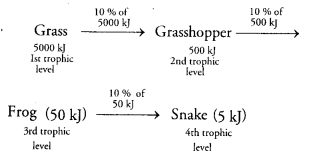
NCERT Solutions for Class 10 Science Chapter 15 Our Environment (Hindi Medium)
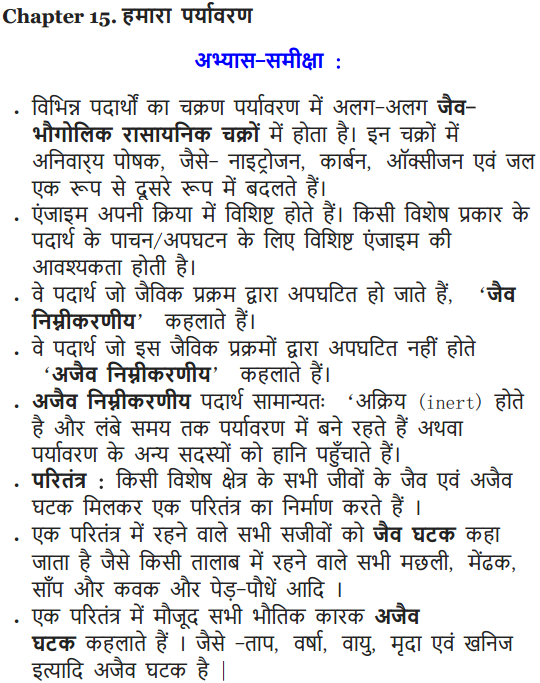
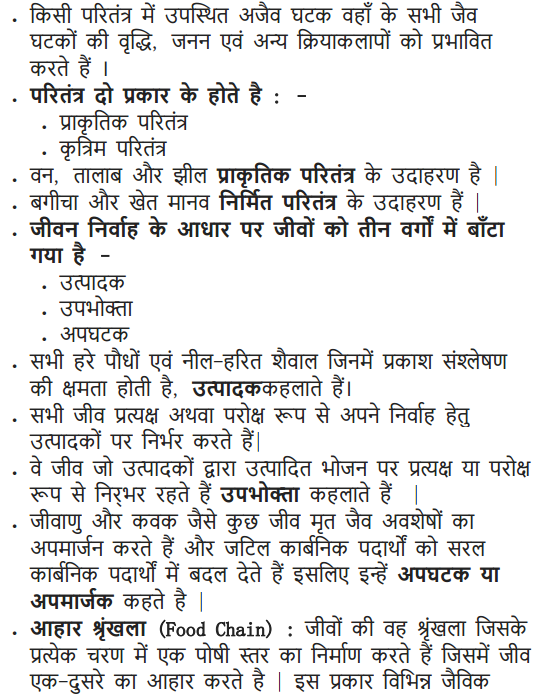
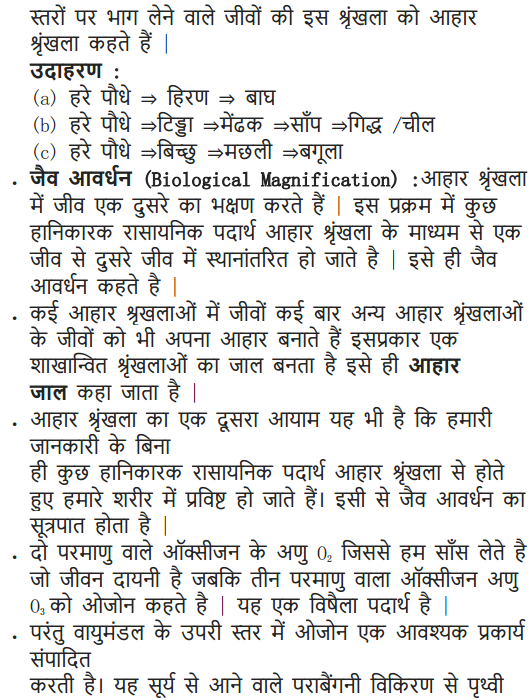
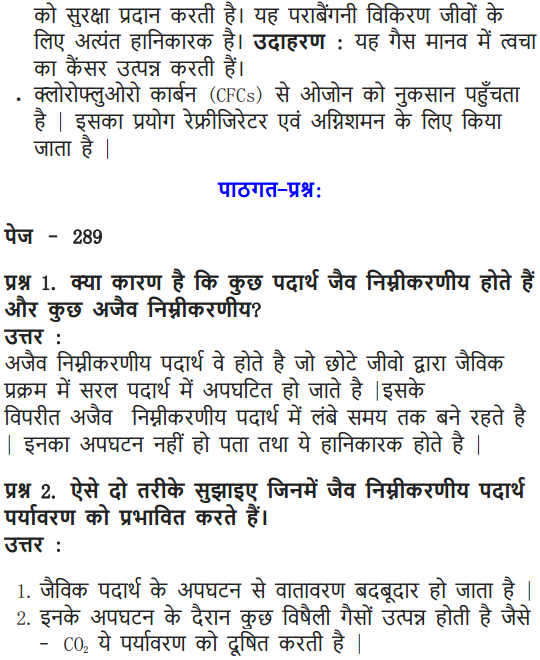
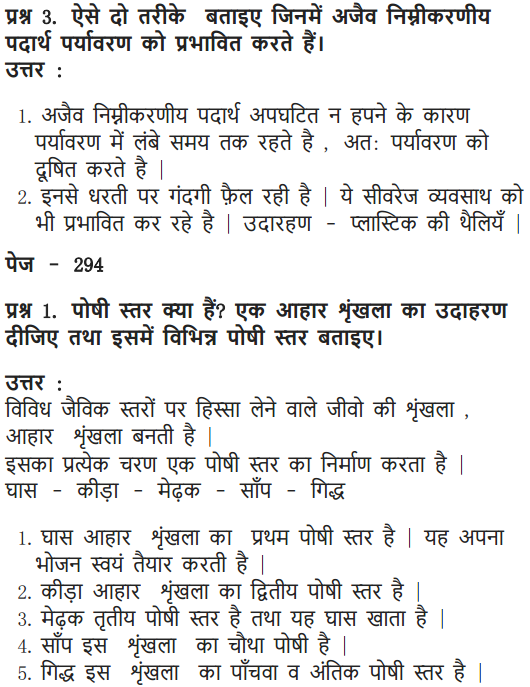
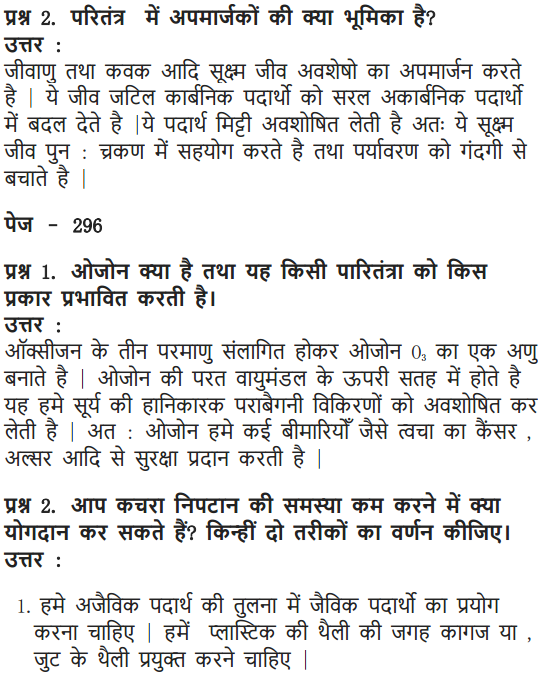
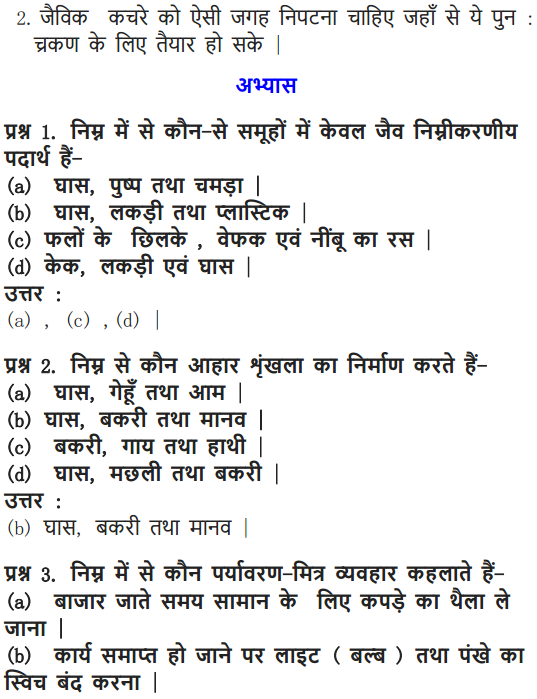
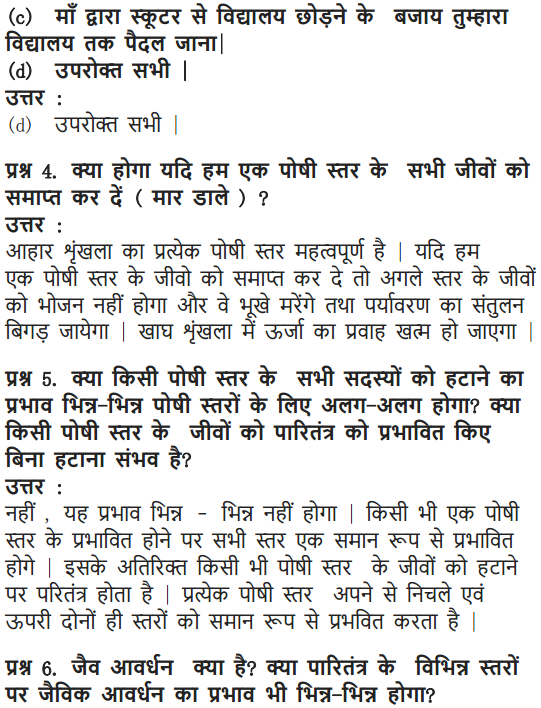
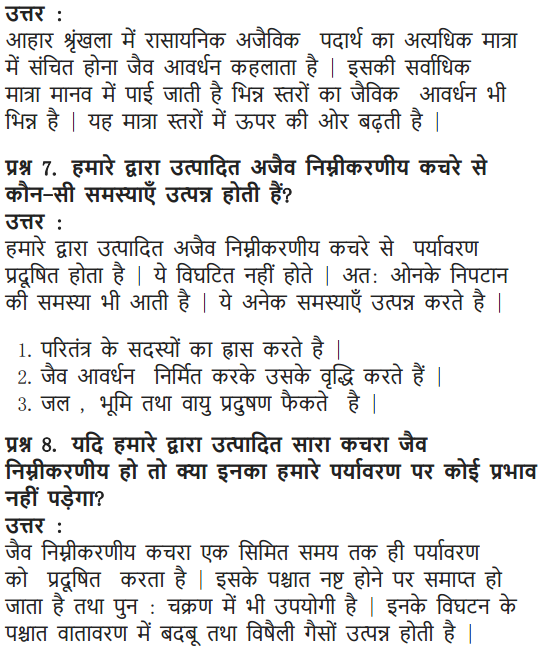
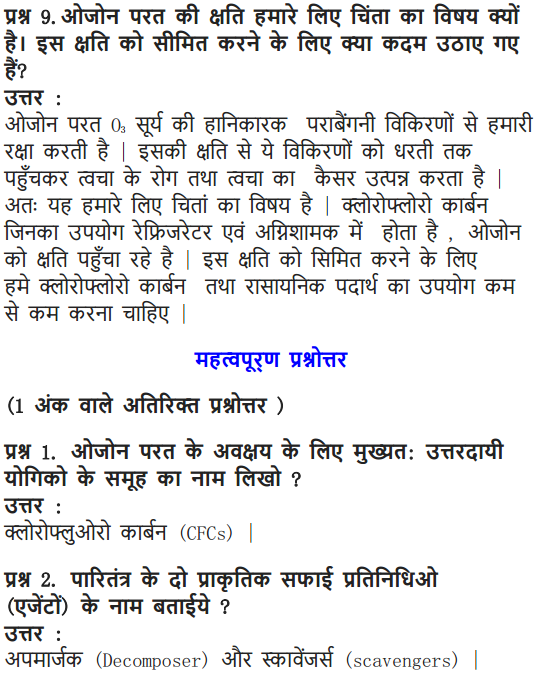
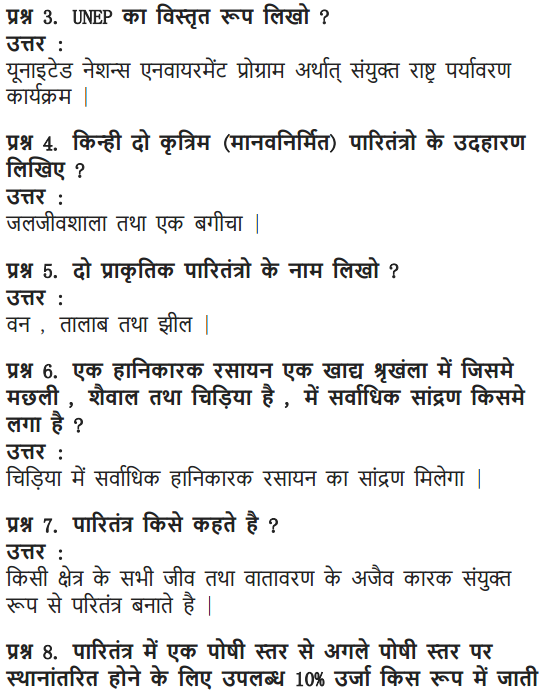
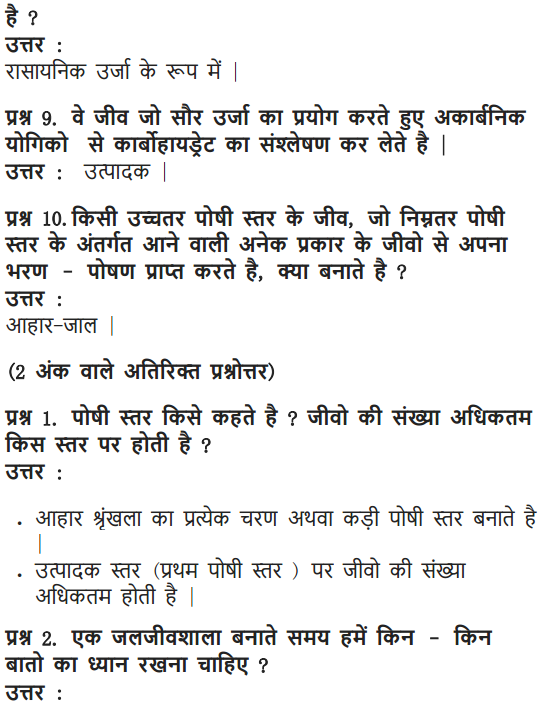
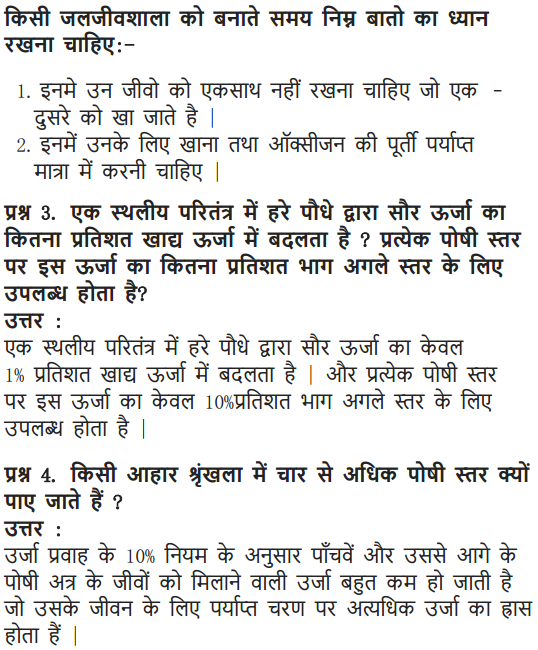
Class 10 Science Our Environment Mind Map
Eco-system
It is defined as functional unit of nature, where living organisms interact among themselves and also with the surrounding physical environment.
Hence, there are two main components of the ecosystem:
Biotic: Living organisms such as plants, animals, microorganisms and humans.
Abiotic: It includes physical factors such as temperature, rainfall, wind, soil and minerals.
Examples of natural ecosystem: forests, ponds, lakes, etc, and human made or artificial ecosystems are gardens, crop-fields, aquarium etc.
Ecosystem consists of various organisms which can be classified as producers and consumers.
Producers are the organisms which make organic compounds like sugar, starch, etc from inorganic substances with the help of sunlight and chlorophyll.
Consumers are the organisms which are dependent on producers for their nutrition. They can be grouped as herbivores, carnivores, omnivores, parasites, and decomposers.
Decomposers are the microorganisms (bacteria & fungi) which break down complex organic substances (dead remains & waste material of living organisms) into simpler inorganic substances that go back into the soil and are used up again by the plants.
Thus, they help in proper cycling of the nutrients in an ecosystem.
Have you ever wondered why we need to clean aquarium but not lakes or ponds?
It is because aquarium is an artificial and incomplete system which lacks producers, food chains, and decomposers.
Hence, it lacks natural nutrients recycling and self¬cleaning abilities. In contrast lake or ponds are natural and complete ecosystem where there is perfect recycling of nutrients and thus does not need to be cleaned very often.
Waste Material
Waste material can be broadly classified into two categories depending on their degradation:
Biodegradable Waste
- These are the wastes that can be broken down into simpler compounds by the action of bacteria or other saprophytes.
- In addition, physical processes such as high temperature and pressure also act on them however, under ambient conditions these substances persist in our environment for a very long time.
- Some examples of such wastes are food materials, kitchen wastes, and other natural wastes.
- Non-biodegradable Waste
- These are the substances that are not broken down into simpler compounds by the action of microorganisms.
- These substances may be inert and simply persist in the environment for a long time or may harm the various members of the eco-system.
- They are the main causes of air, water and soil pollution and diseases like cancer.
- Some examples of such waste are plastic, cans, metals, and chemicals for agricultural and industrial purposes.
Food Chains And Webs
In an ecosystem, there exists a series of organisms feeding on one another. This series or organisms taking part at various biotic levels form a food chain. Alternatively, food chain can be defined as a linear network of food or energy flow starting from producer and ending at apex predator.
Trophic Level
Based on the source of their nutrition or food, organisms occupy a specific place in food chain that is known as their trophic level. There are usually four trophic levels:
- I trophic level: It includes producers or autotrophs for e.g. phytoplankton, grass, trees etc.
- II trophic level: It includes primary consumer or herbivores for e.g. zooplanktons, grasshoppers, cow etc.
- III trophic level: It includes secondary consumer or small carnivore for e.g. birds, fishes, wolf etc.
- IV trophic level: It includes tertiary consumers or larger carni vores for e.g. level lion, tiger, man etc.
Energy Flow
- The flow of energy is unidirectional.
- The green plants in a terrestrial ecosystem capture about 1 % of the energy of sunlight that falls on their leaves and convert it into food energy.
- On an average only 10% organic matter is present at each step and reaches the next level of consumers. It is because a great deal of energy is lost as heat to the environment and rest goes into digestion, in doing work and in growth & reproduction.
- In addition, the loss of energy at each step is so great that very little usable energy remains after four trophic levels and this is the reason that a food chain usually contain maximum of four trophic levels.
- Generally, there are greater number of individuals at lower trophic levels of an ecosystem (the greatest number is of the producers)
- The length and complexity of food chains vary greatly.
- Each organism is generally eaten by two or more other kinds of organisms which in turn are eaten by several other organisms.
- So instead of a straight line food chain, the relationship can be shown as a series of branching lines called a food web.
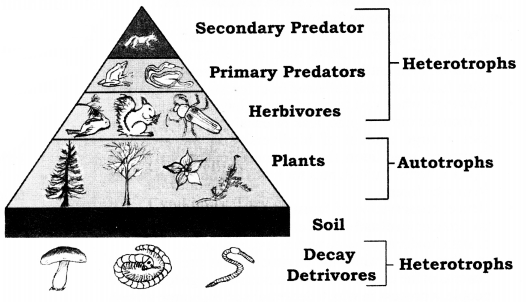
Environmental Problems
Depletion of the ozone layer: Ozone (O3) is a molecule formed by three atoms of oxygen. It is located in upper part of the atmosphere called stratosphere and it acts as shield absorbing UV radiation from sun.
- At higher levels of atmosphere, high energy UV radiations split apart some moleculer oxygen (O2) into free oxygen (O) atoms. These atoms then combine with the molecular oxygen to form ozone.
- Ozone depletion permits entry of harmful UV radiations which lead to diseases like skin aging, irritation & cancer, snow- blindness, cataract, etc.
- Ozone-depleting substances: CFCs, HCFCs, hydrobromofluorocarbons, etc.
Waste disposal: Improvements in our life-style have resulted in greater amounts of waste material generation. For e.g. increased use of disposable items, plastic bags, packing materials etc have resulted in much of our waste becoming non-biodegradable.
Following methods can be helpful in managing the garbage we produce: categorization of waste materials into biodegradable, recyclable & non-biodegradable, reduction in use of non- biodegradable substances such as plastics, thermocol etc, burning & proper dumping of waste.
It is interesting note that how unknowingly some harmful chemicals enter our bodies through the food chain.
It happens by two ways:
Overuse of several pesticides: These chemicals are either washed down into the soil or into the waterbodies.
From the soil, these are absorbed by the plants along with water and minerals, and from the water bodies these are taken up by aquatic plants and animals
Biological magnification: It is defined as an increase in the concentration of the toxicant at successive trophic levels.
These chemicals are not degradable and the organism can neither metabolize nor excrete them and thus they get accumulated progressively at each trophic level.
In addition, human beings occupy the top level in any food chain and thus a maximum concentration of these chemicals gets accumulated in our bodies.
Now that you are provided all the detailed information regarding NCERT Solutions For Class 10 Science Chapter 15 Our Environment and we hope this detailed article on class 10 science chapter 15 NCERT solutions is helpful. If you have any questions regarding this article or NCERT Solutions For Class 10 Science Chapter 15 Our Environment, drop your comments in the comment box below and we will get back to you as soon a possible.
Important Questions of Our Environment Class 10 Science Chapter 15
Human body is made up of five important components ofwhich water is the main component. Food as well as potable water are essential for every human being. The food is obtained from plants through agriculture. Pesticides are being used extensively for a high yield in the fields. These pesticides are absorbed by the plants from the soil along with water and minerals and from the water bodies these pesticides are taken up by the aquatic animals and plants. As these chemicals are not biodegradable, they get accumulated progressively at each trophic level The maximum concentration of these chemicals gets accumulated in our bodies and greatly affects the health of our mind and body.
Question 1.
Why is the maximum concentration of pesticides found in human beings?
Answer:
The pesticides are not biodegradable, they get accumulated progressively at each trophic level. As human beings occupy the topmost level in food chain, their concentration becomes maximum in our bodies.
Question 2.
Give one method which could be applied to reduce our intake of pesticides through food to some extent.
Answer:
By using biological methods for controlling insects in fields and by washing fruits and vegetables before eating could help to reduce our intake of pesticides through food to some extent.
Question 3.
Various steps in a food chain represent:
(a) food web
(b) trophic level
(c) ecosystem
(d) biomagnification.
Answer:
(b) trophic level
Question 4.
With regard to various food chains operating in an ecosystem, man is a:
(a) Consumer
(b) Producer
(c) Producer and consumer
(d) Producer and decomposer. (2020)
Answer:
(a) consumer
Question 5.
Food web is constituted by
(a) relationship between the organisms and the environment
(b) relationship between plants and animals
(c) various interlinked food chains in an ecosystem
(d) relationship between animals and environment. (2020)
Answer:
(c) various interlinked food chains in an ecosystem
Question 6.
What is an ecosystem? (Delhi 2017)
Answer:
An ecosystem is defined as a structural and functional unit of the biosphere. It comprises of living organisms and their non-living environment that interact by means of food chains and biogeo-chemical cycles resulting in energy-flow, biotic diversity and material cycling to form stable self-supporting system.
Question 7.
Why is a lake considered to be a natural ecosystem? (Delhi 2017)
Answer:
Lake is an ecosystem where living organisms grow, reproduce and interact among each other as well as with abiotic components and carry out other activities in nature by themselves without any human interference, therefore it is referred to as a natural ecosystem.
Question 8.
In the following food chain, plants provide 500 J of energy to rats. How much energy will be available to hawks from snakes?
Plants → Rats → Snakes → Hawks (AI 2017)
Answer:
In an ecosystem, only 10% of energy is transferred from one trophic level to next, i.e. 10 percent law and rest is dissipated into the environment. Therefore, if plants (being producers-1st trophic level)-transfer 500 J of energy to rats (2nd trophic level) then rats would transfer 50 J of energy to snakes (3rd trophic level) which in turn will transfer only 5 J of energy to hawks (4th or last trophic level) in a food chain.![]()
Question 9.
In the following food chain, 100 J of energy is available to the lion. How much energy was available to the producers?
Plants → Deer → Lion (AI 2017)
Answer:
As per 10% law of flow of energy in an ecosystem only 10% of energy is received by the next trophic level. Hence, in the given food chain : If 100 .J of energy is available to lion, the plants or producers have 10,000 J of energy available to them.![]()
Question 10.
List two biotic components of a biosphere. (Delhi 2016)
Answer:
Two biotic components of a biosphere are:
(i) Producers – Include organisms which can produce their food using simple inorganic compounds, e.g., all green plants, blue green algae (cyanobacteria).
(ii) Consumers – Include organisms which are unable to synthesise their food, therefore, utilise materials and energy stored by the producers or eat other organisms, e.g., all the animals.
Question 11.
Why are green plants called producers? (Delhi 2016)
Answer:
Green plants are called producers because they manufacture their own food with the help of CO2 and H2O in the presence of sunlight and chlorophyll.
Question 12.
In a food chain of frog, grass, insect and snake, assign trophic level to frog. (AI 2016)
Answer:
In the given food chain, frog belongs to the third trophic level as shown here :![]()
Question 13.
Why do producers always occupy the first trophic level in every food chain? (Foreign 2016)
Answer:
Producers are the green plants that can manufacture food using CO2 and H2O in the presence of sunlight, i.e., they are autotrophs. They serve as a source of food for all non-producers or consumers directly or indirectly. Hence, producers occupy the first trophic level in a food chain.
Question 14.
We often use the word environment. What does it mean? (Foreign 2016)
Answer:
Environment can be defined as the physical or biological world where an organism lives. Literally speaking, an organisms immediate surrounding constitutes its environment which includes both biotic and abiotic components around him.
Question 15.
Which of the following are always at the second trophic level of food chains? Carnivores, Autotrophs, Herbivores (AI 2015)
Answer:
Herbivores always occupy the second trophic level of food chains.
Question 16.
The following organisms form a food chain. Which of these will have the highest concentration of non-biodegradable chemicals? Name the phenomenon associated with it. Insects, Hawk, Grass, Snake, Frog (Foreign 2015)
Answer:
Among the following organisms of the food chain, hawk being top consumer is present at topmost trophic level, hence will have the highest concentration of non-biodegradable chemicals due to a phenomenon known as biomagnification.
Question 17.
List two examples of natural ecosystem. (Foreign 2015)
Answer:
The two examples of natural ecosystem are :
- Forest ecosystem
- River ecosystem
Question 18.
What is meant by the term ‘Biomass? (Board Term I, 2014)
Answer:
Biomass is the total amount of living or organic matter in an ecosystem at any time.
Question 19.
Bacteria and fungi are called decomposers. Why? (Delhi 2012, Foreign 2011)
Answer:
Bacteria and fungi are called decomposers because these microorganisms break down the complex organic matter present in dead plants and animals into simpler substances.
Question 20.
In a food chain, if 10,000 joules of energy is available to the producer, how much energy will be available to the secondary consumer to transfer it to the tertiary consumer? (AI 2012)
Answer:
According to ten percent law, 10% of the energy of producer will be available to primary consumer, and 10% of this energy will be available to secondary consumer and so on.
Hence, 100 J of energy will be available to the secondary consumer to transfer it to tertiary consumer.
Question 21.
Consider the following food chain which occurs in a forest:
Grass → Deer → Lion
If 10000 J of solar energy is available to the grass, how much energy would be available to the deer to transfer it to the lion? (Foreign 2012)
Answer:
The energy available to the deer is 1000 J to transfer it to the lion. This can be depicted as follows:
Question 22.
What is meant by biological magnification? (AI 2011)
Answer:
Biological magnification or biomagnification refers to the process of accumulation of non- biodegradable chemicals (pesticides, etc.) into the body of organisms through the food chain which go on increasing in its concentration at each trophic level.
Question 23.
Give an example to illustrate that indiscriminate use of pesticides may result in the degradation of the environment. (AI 2011)
Answer:
Pesticides are the chemicals used to kill plant and animal pests. They are non-biodegradable and toxicants. For example, excessive use of DDT resulted in reduced population of fish eating birds. DDT accumulated in such birds through the food chain. It interfered with the egg shell formation. The shell being thin broke due to weight of the bird during incubation. Hence, their population declined.
Question 24.
What are decomposers? List two important roles they play in the environment. (AI 2014)
Answer:
Decomposers are microorganisms including bacteria and fungi which decompose or break-down the complex organic compound present in dead plants and animals into simpler substances. Role of decomposers in environment are-
- They help in decomposing dead bodies of plants and animals and hence act as cleansing agents of environmcnl.
- ‘They help in recycling of materials in the ecosystem lo maintain its stability.
Question 25.
List two reasons to show that the existence of decomposers is essential in an ecosystem. (AI 2014)
Answer:
The existence of decomposers in an ecosystem is essential because:
(i) If there were no decomposers, then the dead bodies of plants and animals would keep lying as such and the elements constituting plant and animal bodies would never be returned to their original pools like soil, air and water. In such case the organic waste go on accumulating and the cyclic process of life and death would be disrupted.
(ii) Decomposers make the soil fertile by providing/replenishing nutrients to it, thus forming the integral part of ecosystem.
Question 26.
State with reason any two possible consequences of elimination of decomposers from the earth. (AI 2014)
Answer:
Consequences of elimination of decomposers are:
(i) There would be no recycling of nutrients and therefore, raw materials to produce food will not be available to producers. Hence, the food chains will get affected.
(ii) The dead bodies of plants and animals will go on accumulating in the absence of decomposition thereby polluting the environment.
Question 27.
What does a trophic level represent in a food chain? State the position of autotrophs and herbivores in a food chain. (Delhi 2013C)
Answer:
Trophic level represents each of several hierarchical levels of a food chain operating in an ecosystem, consisting of organism sharing the same function in the food chain and the same nutritional relationship to the primary sources of energy.
The position of producers (or autotrophs) in a food chain constitute the first trophic level. They fix up sun’s energy and make it available for consumers. The herbivores or primary consumers (which feed upon plants) constitute the second trophic level in a food chain.
Question 28.
(a) From the following group of organisms create a food chain which is most advantageous for human beings in terms of energy.
Hawk, Rat, Cereal plant, Goat, Snake, Human being
(b) State the possible disadvantage if the cereal plant is growing in soil rich in pesticides.
(c) Construct a food web using the organisms mentioned above. (2020)
Answer:
(a) A food chain which is most advantageous for human beings in terms of energy is:
Cereal plant → Human being
(b) If the cereal plant is growing in soil rich in pesticides, these pesticides are absorbed by growing plants along with water and minerals, when animals eat these cereal plants, these poisonous chemical pesticides go into their bodies through food. This increase in concentration of harmful pesticides in the body of living organisms at each trophic level of a food chain is called biological magnification. Pesticides are lethal to non-target species also. The extensive use of pesticides in agriculture can change the community of microorganisms living in soil.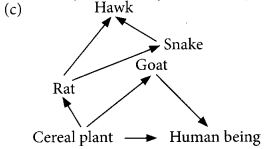
Question 29.
(a) Create a food chain of the following organisms.
Insect, Hawk, Grass, Snake, Frog
(b) Name the organism at the third trophic level of the created food chain.
(c) Which organism of this food chain will have the highest concentration of non- biodegradable chemicals?
(d) Name the phenomenon associated with it.
(e) If 10,000 Joules of energy is available to frogs, how much energy will be available to snakes in this food chain? (2020)
Answer:
(a) Grass → Insect → Frog → Snake → Hawk
(b) Frog is present in the above created food chain.
(c) Hawk is the top consumer of the food chain, so, it will have high concentration of non- biodegradable chemicals.
(d) Biological magnification
(e) As per 10% law of flow of energy in an ecosystem, only 10% of energy is received by the next trophic level. Hence, in the given food chain, if 10,000 Joules of energy is available to frog, then the energy available to snakes will be 1000 Joule.![]()
Question 30.
(a) What is an ecosystem?
(b) List any two natural ecosystems.
(c) We do not clean ponds or lakes but an aquarium needs to be cleaned regularly. Why? (2020)
Answer:
(a) An ecosystem is defined as a structural and functional unit of the biosphere comprising of living organisms and their non-living environment.
(b) Two examples of natural ecosystem are: pond ecosystem and grassland ecosystem.
(c) Ponds or lakes being natural ecosystems are self sufficient and do not need to be maintained regularly. On the other hand, aquarium being an artificial ecosystem needs to be cleaned and maintained regularly as it contains mainly fishes as living organisms, as compared to natural ecosystems where presence of other organisms maintains a balance. Also, because the producers and decomposers are absent in aquarium the fish waste or excretory products, i.e., ammonia may turn into toxic compounds and accumulate to dangerous levels causing the fishes to die. Hence, the artificial ecosystems like aquarium needs to be cleaned regularly.
Question 31.
What is meant by trophic level in a food chain? Construct a terrestrial food chain with trophic levels. The energy flow in a food chain is always unidirectional. Why? (2020)
Answer:
The various steps representing organisms in a food chain at which the transfer of food and energy takes place are called trophic levels.
Four trophic levels in a terrestrial food chain:
Grass → Rabbit → Wild cat → Tiger
There is a unidirectional llow of energy from sun to producers and subsequenllv to series of different types of consumers, i.e.,
Solar radiations → Producers → Herbivores → Carnivores
It cannot pass in reverse direction, lhcre is always a decrease in the flow of energy and content with rise in trophic level. Large quantity of energy is lost at each step in the form of heat and is also used up in various metabolic activities.
Question 32.
Complete the following flow chart based on ecosystem and its components.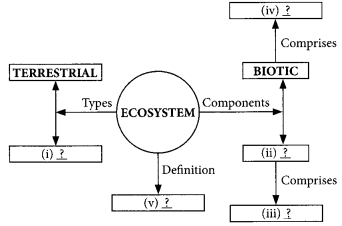
Answer:
- Aquatic
- Abiotic
- Inorganic substances
- Producers
- Structural and functional unit of biosphere
Question 33.
(a) Construct a terrestrial food chain comprising four trophic levels.
(b) What will happen if we kill all organisms in one trophic level?
(c) Calculate the amount of energy available to the organisms at the fourth trophic level. If the energy available to the organisms at the second trophic level is 2000 J. (2020)
Answer:
(a) A terrestrial food chain with four trophic levels is :
Grass → Insect → Frog → Eagle
(b) Removal of the organisms of any trophic level will always adversely affect the ecosystem, e.g., the removal of lions and tigers (top carnivores) will cause rapid increase in deer population, which leads to rapid consumption of vegetation resulting in scarcity of vegetation and population crash of deer.
(c) According to ten percent law, only 10% of the energy is received by the next trophic level.
If the energy available at second trophic level (T2) is 2000 J, so the 20 J of energy will be at fourth trophic level (T4).
Question 34.
Define an ecosystem. Draw a block diagram to show the flow of energy in an ecosystem. (Delhi 2019)
Answer:
An ecosyslcm is defined as a structural and functional unil of ihe biosphere. It comprises of living organisms and their non-living environment that interact by means of food chains and biogeo-chemical cycles resulting in energy-flow, biotic diversity and material cycling to form stable self-supporting system.
Green plants capture about 1% of the solar energy incident on the earth to carry out the process of photosynthesis. A part of this trapped energy is used by plants in performing their metabolic activities and some energy is released as heat into the atmosphere. The remaining energy is chemical energy stored in the plants as photosynthetic products. When these green plants are eaten up by herbivores, the chemical energy stored in the plants is transferred to these animals. These animals (herbivores) utilise some of this energy for metabolic activities and some energy is released as heat while the remaining energy is stored in their body. This process of energy transfer is repeated till top carnivores. In an ecosystem, transfer of energy follows 10 percent law, i.e,, only 10 percent of the energy is transferred to each trophic level from the lower trophic level. Nearly 90 percent of energy is lost when it moves from one trophic level to the next.
The given block diagram shows unidirectional flow of energy at different trophic levels in a freshwater ecosystem: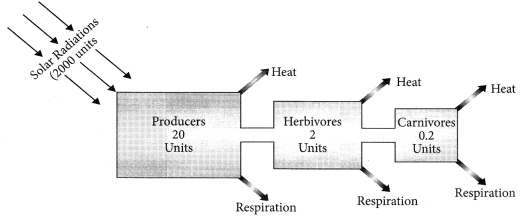
Question 35.
What is a food chain? Why is the flow of energy in an ecosystem unidirectional? Explain briefly. (AI 2019)
Answer:
The sequential interlinking of organisms involving transfer of food energy from the producers, through a series of organisms with repeated eating and being eaten is called the food chain. A food chain involves a nutritive interaction between the living organisms of an ecosystem. There is a unidirectional flow of energy from sun to producers and subsequently to series of different types of consumers, i.e.,
Solar radiations → Producers → Herbivores → Carnivores
It cannot pass in reverse direction. There is always a decrease in the flow of energy and content with rise in trophic level. Large quantity of energy is lost at each step in the form of heat and is also used up in various metabolic activities.
Question 36.
“Energy flow in food chains is always unidirectional.” Justify this statement.
Explain how the pesticides enter a food chain and subsequently get into our body. (Foreign 2015, AI 2014)
Answer:
Refer to answer 35.
Some harmful non-biodegradable chemicals (pesticides, e.g., D.D.T.) enter the bodies
of organisms through the food chains and get concentrated at each trophic level. This phenomenon is called biomagnification or biological magnification. For example, in a food chain operating in a pond, river or lake, the water contains a small amount — 0.02 ppb (parts per billion) of harmful pesticides, i.e., D.D.T. When this water is consumed by phytoplanktons and zooplanktons, the concentration of these chemicals increases to 5 ppm. Fishes feeding on these, accumulate 240 ppm. Birds and humans feeding on these fishes were found to contain 1600 ppm of these chemicals. Thus, there is an increase in the concentration of the chemicals at each trophic level.
Question 37.
“Our food grains such as wheat and rice, the vegetables and fruits and even meat are found to contain varying amounts of pesticide residues.” State the reason to explain how and why it happens. (Delhi 2014)
Answer:
Pesticides are poisonous chemical substances which are sprayed over crop plants to protect them from pests and diseases. These chemical pesticides mix up with soil and water. From soil and water, these pesticides are absorbed by the growing plants along with water and other minerals. When herbivorous animals feed on these plants the poisonous pesticides enter their bodies through the food chain. Similarly, when the carnivorous animals eat these herbivores, the pesticides get transferred to their bodies. Therefore, the plant products such as food grains, vegetables and fruits as well as meat of animals contain varying amounts of pesticide residues in them depending upon the trophic level they occupy in a food chain.
Question 38.
What is meant by food chain? “The number of trophic levels in a food chain is limited.” Give reason to justify this statement. (Foreign 2014)
Answer:
The sequence of living organisms in a community in which one organism consumes or feeds upon another organism to transfer food energy, is called a food chain. The various steps in a food chain at which the transfer of food (or energy) takes place are called trophic levels. In fact, in a food chain, each step representing an organism forms a trophic level.
The number of trophic levels in a food chain are limited because at each trophic level only 10% of energy is utilised for the maintenance of organism which occur at that trophic level and the remaining large portion is lost as heat. As a result organisms at each trophic level pass on lesser energy to the next trophic level, than they receive. The longer the food chain, the lesser is the energy available to the final member of food chain. Food chains generally consist of three or four trophic levels because beyond that the energy available to the next organism will be too small and insufficient to sustain the life of that organism.
Question 39.
(a) What is an ecosystem? List its two main components.
(b) We do not clean ponds or lakes, but an aquarium needs to be cleaned regularly. Explain. (Delhi 2013)
Answer:
(a) Refer to answer 34.
The two main components of ecosystem are :
- Abiotic components – Non-living components of ecosystem, e.g., soil, water, air, light, etc.
- Biotic components – Living components of ecosystem, e.g., plants, animals and microbes.
(b) Refer to answer 30 (c).
Question 40.
Choose the incorrect statement from the following:
(a) Ozone is a molecule formed by three atoms of oxygen.
(b) Ozone shields the surface of the earth from ultraviolet radiations.
(c) Ozone is deadly poisonous.
(d) Ozone gets decomposed by UV radiations. (2020)
Answer:
(d) Ozone gets decomposed by UV radiations. (2020)
Answer questions numbers 41 to 44 on the basis of your understanding of the following paragraph and the related studied concepts:
India today is facing the problem of overuse of resources, contamination of water and soil and lack of methods of processing the waste. The time has come for the world to say goodbye to “single use plastics”. Steps must be undertaken to develop environment-friendly substitutes, effective plastics waste collection and methods of its disposal. Indore treated 15 lakhs metric tonnes of waste in just 3 years, through biomining and bioremediation techniques. Bioremediation involves introducing microbes into a landfill to naturally ‘break’ it down and biomining involves using trommel machines to sift through the waste to separate to ‘soil’ and the waste component. The city managed to chip away 15 lakh metric tonnes of waste at a cost of around t 10 crore. A similar experiment was successfully carried out in Ahmedabad also.
Question 41.
State two methods of effective plastic waste collection in your school.
Answer:
Two methods of effective plastic waste collection : (i) Use of separate dustbins for plastic collection (ii) Use of reusable for the canteen and school events (iii) Encourage less plastic in packed lunches.
Question 42.
Name any two uses of ‘single use plastic’ in daily life.
Answer:
Single use plastic, often also referred to as disposable plastics are commonly used for plastic packaging and include items intended to be use only once before they are thrown away or recycled. These include grocery bags, food packaging, bottles, straws, containers, cups and cutlery.
Question 43.
If we discontinue the use of plastic, how can an environment-friendly substitute be provided?
Answer:
Best alternatives’can be use of stainless steel, glass and platinum. Silicone storage containers. Cloth bags can be used in place of plastic bags. Use of wooden cleaning brushes, kitchen utensils and cutting board, pottery and other ceramics products, etc.
Question 44.
Do you think microbes will work similarly in landfill sites as they work in the laboratory? Justify your answer. (2020)
Answer:
Microbes may not work exactly the same way in landfill sites as they work in laboratories because it is difficult to replicate the exact ambient conditions required for the microbes to thrive in these two conditions. But due to same downstream processing and other mechanism, they will work similarly in landfill sites.
Question 45.
The depletion of ozone layer is a cause of concern. Why? (AI 2016)
Answer:
Ozone layer is the ozone rich area in the stratospheric layer of atmosphere which acts as a protective shield by preventing harmful UV radiations from entering the Earth surface. Hence, the depletion of ozone layer is a cause of concern.
Question 46.
Write one negative effect on the environment, of affluent life style of few persons of a society. (Al 2016, 2014)
Answer:
Affluent lifestyle of few persons leads to exploitation and over consumption of resources leading to their scarcity and generation of greater amount of waste materials which causes imbalance in environment.
Question 47.
Why is excessive use of CFCs a cause of concern? (Foreign 2016)
Answer:
CFCs or Chlorofluorocarbons are potent compounds that release active chlorine in the atmosphere which reacts with ozone molecules present there to convert them to oxygen. This results in thinning of ozone layer. Hence, excessive use of CFCs is a cause of concern.
Question 48.
What is the function of ozone in the upper atmosphere? (Delhi 2015, Foreign 2012)
Answer:
Ozone (O3) gas forms a protective shield in the upper atmosphere that absorbs most of the harmful ultraviolet radiations coming from Sun that can harm human beings, animals and plants. It protects us from various health hazards.
Question 49.
Why should biodegradable and non- biodegradable wastes be discarded in two separate dustbins? (Delhi 2015, 2013)
Answer:
Biodegradable wastes are decomposed naturally by the action of microbes which degrade them to their simple constituents enabling their nutrients to recycle among the biotic and abiotic components of ecosystem. However, non-biodegradable wastes cannot be disposed off naturally since they cannot be decomposed by microbes. Such wastes are either recycled, incinerated or put in landfills, etc. As the disposal methods of the two types of waste is different, it is advisable to discard the two types of waste in two separate dustbins.
Question 50.
Write the full name of the group of compounds mainly responsible for the depletion of ozone layer. (Foreign 2015, Delhi 2013C)
Answer:
Chlorofluorocarbons (CFCs) are the group of compounds mainly responsible for ozone depletion.
Question 51.
Which class of chemical is linked to the decrease in the amount of ozone in the upper atmosphere of the Earth? (Delhi 2012)
Answer:
The decrease in the amount of ozone in the atmosphere has been linked to synthetic chemicals like chlorofluorocarbons (CFCs) which are used as coolant and in fire extinguishers, etc.
Question 52.
What happens when higher energy ultraviolet radiations act on the oxygen at the higher level of the atmosphere? (Al 2012)
Answer:
When high energy ultraviolet radiations react with oxygen present in stratosphere (the higher level of atmosphere) it splits into its constituent atoms. Since these atoms produced are very reactive they react with molecular oxygen (O2) to form ozone (O3).
Question 53.
Why did United Nations act to control the production of chlorofluorocarbons (CFCs) used in refrigerators? (Delhi 2011)
Answer:
United Nations act to control the production of CFCs as they are the main chemicals responsible for ozone depletion.
Question 54.
Why is decrease of ozone in our ozone layer a cause for our worry? (Foreign 2011)
Answer:
Refer to answer 45.
Question 55.
“Industrialisation has adversely deteriorated the environment.” Give four reasons in support of this statement. (Foreign 2016)
Answer:
Industrialisation has deteriorated our environment in the following ways :
- Rapid industrialisation has increased the demand of more land area for setting up of new factories. This demand is being fulfilled by clearing up of forest area. Deforestation is one of the major causes of ecological imbalance, biodiversity loss and ecosystem unstability.
- Industries release various harmful gases in the environment which pollute the air. These gases when inhaled by people around, cause various respiratory diseases in them.
- A lot ol effluent and liquid waste is discharged from various industries which is mostly dumped into nearby water bodies. This causes water pollution. Polluted water causes death of various aquatic organisms and consumption of this polluted water causes various diseases in humans.
- The solid waste released from factories is dumped on open land and not treated properly to ensure their proper decomposition. Ibis leads to land pollution that degrades quality of soil and also causes various kinds of diseases in humans and animals.
Question 56.
Why is Government of India imposing a ban on the use of polythene bags? Suggest two alternatives to these bags and explain how this ban is likely to improve the environment. (Delhi 2014)
Answer:
Government of India is imposing a ban on the use of polythene hags because these are non-bindegradahle substances which are not acted upon by the microbes. So, they cannot be decomposed and therefore persist in the environment for a long time thereby causing harm to the ecosystem. I’oh bags choke drains which results in water logging, that allows breeding of mosquitoes and hence leads to various diseases like malaria, dengue, etc. Jute bags and cloth bags are the alternatives to the polythene bags.
Question 57.
In some states of our country there is a ban on the use of polythene bags for shopping. Why? List three advantages of using jute or cloth bags over polythene bags. (Delhi 2014)
Answer:
Refer to answer 56.
The three advantages of using jute or cloth bags over polythene bags are :
- They are made of biodegradable material.
- They can be reused.
- They do not pollute our environment.
Question 58.
“Affluent life style has a negative effect on the environment.” Justify this statement with the help of an example. (Delhi 2014)
Answer:
With the advancement in technology over time, there has been improvement in lifestyle of people. Such changes in peoples lives have also changed their attitudes. When people have more resources at their end they tend to overuse and misuse it thereby generating huge amounts of wa>le material. for example, the atllueiit life style has forced people to start using more of disposable articles, e.g., plastic cups, bags, etc., which keep on accumulating in the environment and lie undecomposed, therein negatively a Heeling the environment.
Similarly, excessive use of refrigerators and air conditioners, plastic foams, etc., also releases high quantities of CFCs which are responsible for ozone depletion.
Question 59.
Give one example each from your daily life where the domestic waste can be effectively reused and recycled. (AI 2014)
Answer:
We can reuse plastic and glass jars of jams and pickles, etc, for the purpose of storage of things like salt, sugar, tea, etc., whereas we can recycle newspapers, plastic of some types, broken glass and metal wares for making fresh paper, plastic, glass and metal objects.
Question 60.
“To discard the household waste we should have two separate dust-bins, one for the biodegradable waste and the other for the non-biodegradable waste.” Justify this statement suggesting the proper way of disposal of these wastes. (Foreign 2014)
Answer:
“To discard the household waste we should have two separate dust-bins, one for the biodegradable waste and the other for the non-biodegradable waste.” Segregation of biodegradable and non- biodegradable waste is utmost important for their proper disposal, as different methods are adopted for their disposal, biodegradable wastes can be composted whereas non-biodegradable wastes can be recycled, incinerated or landfilled.
Question 61.
We often observe domestic waste decomposing in the bylanes of residential colonies. Suggest ways to make the residents realise that the improper disposal of their waste is harmful to the environment. (Foreign 2014, Delhi 2013)
Answer:
Some of the ways to make people realise that the improper disposal of waste is harmful to the environment includes making people aware of negative impacts of waste disposal. They can be made aware by:
(i) Conducting seminars about the negative effects of the wastes on environment.
(ii) Usage of pamphlets and posters for providing information.
(iii) Forming an eco-club in the society for spreading awareness about the ill effects of waste on the surroundings such as :
- Improper disposal of waste will release harmful gases in the environment that make it unclean and unhygienic for the living organisms.
- The waste will flow to water bodies along with rain water and become a threat to aquatic life and pollute the water bodies.
- It provides space for breeding of the mosquitoes and which results in spread of malaria, filariasis, dengue, etc.
- Hazardous chemicals from wastes get into the soil and can harm the plants when they take up the contamination through their roots. This will affect the health of other animals and humans and will have negative impact on environment.
Question 62.
Suppose you find a heap of domestic waste, in a nearby park, which is decomposing. What would you do to make the people of the surrounding area realise that such type of disposal of domestic waste is harmful to the environment? (Foreign 2014)
Answer:
Refer to answer 61.
Question 63.
(a) Write two harmful effects of using plastic bags on the environment. Suggest alternatives to the usage of plastic bags.
(b) List any two practices that can be followed to dispose off the waste produced in our homes. (2020)
Answer:
(a) Two harmful effects of using plastic bags on the environment:
(i) Plastic bags are non-biodegradable substances which are not acted upon by microbes. So, they cannot be decomposed and therefore persist in the environment for a long time causing harm to the soil fertility and quality.
(ii) Plastic bags choke drains which result in waterlogging, that allows breeding of mosquitoes and hence leads to various diseases.
Jute bags and cloth bags are the alternatives to the polyethene bags.
(b) Practices that can be followed to dispose off the waste produced in our homes:
- Separation of biodegradable and non- biodegradable wastes.
- The biodegradable waste can be converted to manure.
- Non-biodegradable waste should be disposed off at suitable places from where municipal authorities can pick them up and dispose properly and scientifically.
- Use discarded bottles and jars to store food, items.
Question 64.
(a) Complete the following table :
| Oxygen | Ozone | |
| Formula | (i) …………. | (ii) ………….. |
| Benefits to biotic component | (iii) ………….. | (iv) …………….. |
(b) How is ozone formed at the higher level of atmosphere? (2020)
Answer:
(a) (i) O2
(ii) O3
(iii) Respiration
(iv) Absorbs harmful ultraviolet radiations coming from the sun.
(b) When high energy ultraviolet radiations react with oxygen present in stratosphere (the higher level of atmosphere) it splits into its constituent atoms. Since these atoms produced are very reactive they read with molecular oxygen (O2) to form ozone (O3).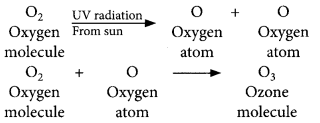
Question 65.
You have been selected to talk on “Ozone layer and its protection” in the school assembly on ‘Environment Day’.
(a) Why should ozone layer be protected to save the environment?
(b) List any two ways that you would stress in your talk to bring in awareness amongst your fellow friends that would also help in protection of ozone layer as well as the environment. (Delhi 2017)
Answer:
(a) The ozone layer is very important for the existence of life on earth because it forms a protective shield around earth by absorbing most of the harmful ultraviolet (UV) radiations coming from the Sun and prevents them from reaching the Earth.
The UV radiations have extremely harmful effects on human beings, animals and plants as well, i.e., cause mutations, skin cancer, cataract, damage immune system, etc. So, ozone layer must be protected to save the environment.
(b) The two ways which can help in protection of ozone layer and environment are :
(i) The use of chemicals like chlorofluorocarbons (CFCs) which are widely used in refrigerators and air conditioners (as a coolant), in fire extinguishers and in aerosol sprayers destroy the ozone layer gradually. We can protect our ozone layer by avoiding the use of such objects which are releasing UFCs.
(ii) Nitrous oxide is the largest ozone depleting substance as well as greenhouse gas released by human activities, such as from motor vehicles, fertilisers. People should be encouraged to use more public transport, car pooling, using hybrid or electric cars and use of fertiliser formulations to reduce emission of nitrous oxide.
Question 66.
After the examinations Rakesh with his friends went on a picnic to a nearby park. All friends carried cooked food packed in plastic bags or plastic cans. After eating the food some friends collected the leftover food and plastic bags etc., and planned to dispose them off by burning. Rakesh immediately checked them and suggested to segregate the leftover food and peels of fruits from the plastic materials and respectively dispose them off separately in the green and red dustbins placed in the corner of the park.
(a) In your opinion, is burning plastic an eco-friendly method of waste disposal? Why? State the advantage of method suggested by Rakesh.
(b) How can we contribute in maintaining the parks and roads neat and clean? (Delhi 2015)
Answer:
(a) No, burning plastic is not an eco-friendly method of waste disposal, burning plastics can produce toxic fumes and cause air pollution. Plastic, being non-biodegradable cannot be dumped (land filled), so the best way to dispose plastic items is to recycle them. Recycling is a less polluting and more sustainable option.
Rakesh segregated left over food items, fruit peels, i.e., biodegradable waste and plastic material, i.e., non-biodegradable waste. The biodegradable waste can be converted to manure whereas non-biodegradable waste can be recycled. This contributes in decreasing the level of pollution and easy disposal and treatment of waste.
(b) We can contribute to keep our roads and parks clean by adopting following habits:
- We should recycle non-biodegradable waste products instead of dumping it in garbage.
- We should use carry bags made of natural fibre as jute, cloth, instead of plastic bags.
- We should make compost of biomass collected from park such as food waste, leaf litters, etc,.
- We should stop littering, throwing garbage and spitting on road sides, parks, etc.
Question 67.
Differentiate between biodegradable and non-biodegradable substances with the help of one example each. List two changes in habit that people must adopt to dispose non-biodegradable waste, for saving the environment. (A I2015, Delhi 2013C)
Answer:
Differences between biodegradable and non- biodegradable wastes are as follows:
| Biodegradable Wastes | Non-biodegradable Wastes |
| (i) These are biological in origin. | These are mostly man-made. |
| (ii) These are degraded by microorganisms such as bacteria and fungi. | These are not degraded by micro-organisms. |
| (iii) These do not get biologically magnified in food chains. | These enter into the food chains and get biologically magnified. |
| (iv) These can be converted into resource. Examples-sewage, cattle dung, household garbage, etc. | Some of these can be recycled. Examples-plastic objects, synthetic fibres, glass objects, etc. |
People should adopt the following changes in their habit to dispose off non-biodegradable waste, so as to save the environment.
- Non-biodegradable household waste should be disposed in separate dustbins and should not be mixed with biodegradable waste.
- Recyclable „ non-biodegradable wastes like glass, paper, metal, various types of plastics etc., can be sent to local recycling units.
- People should try to reuse items as much as possible instead of disposing them as this reduces need of new materials and keeps ecological impact down.
- Use of cloth bags/gunny bags/paper bags instead of polythene /plastic bags.
- Use of compost, vermicompost instead of fertilisers.
Question 68.
What is ozone ? How and where is it formed in the atmosphere ? Explain how does it affect an ecosystem. (Foreign 2015)
Answer:
Ozone is a form of oxygen. It is a made up of three atoms of oxygen. It is highly poisonous. However, good amount of ozone is present in upper part of the atmosphere called stratosphere. In the stratosphere ozone is being photo- dissociated and generated simultaneously by absorption of harmful ultraviolet (UV) radiations coming from sun.![]()
The two reactions are in equilibrium thereby maintaining a steady concentration of ozone in the stratosphere. Ozone layer is commonly called ozone blanket. It acts as a protective shield to protect all types of life from the harmful effect of UV radiation. Therefore, any thinning or depletion of ozone layer allows entry of high energy UV radiations into the earth’s surface, thereby causing harmful effects on plants, animals and human beings.
The harmful effects of ozone depletion on man, animals and plants includes :
- Incidences of skin cancer and herps.
- Damage to eye sight, photoburning as well as increased incidences of cataract in eyes.
- Damage to immune system and hence lowering the body’s resistance to disease.
- Increased embryonic mortality.
- 10-25% decline of photosynthesis in plants.
- Global warming.
CBSE Class 10 Science Notes Chapter 15 Our Environment
Biodegradable and Non-biodegradable Wastes, Ecosystem, Components of Ecosystem. The environment includes our physical surroundings like air (or atmosphere), water bodies, soil (land and all the organisms such as plants, animals, human beings and micro-organisms like bacteria and fungi (called decomposers). The waste materials produced by the various activities of man £nd animals are poisonous to some extent and can be divided into two main groups
1. Biodegradable Wastes: Substances that are broken down by the biological processes are said to be biodegradable. These substances are decomposed through the actions of fungi, bacteria, and other living organisms. Temperature and sunlight also play an important role in the decomposition of biodegradable substances.
For Examples: Food waste, trees leaves, urine and fecal matter, sewage agricultural residue, paper, wood, cloth, cow-dung etc.
2. Non-Biodegradable Wastes: Substances that are not broken down by biological
processes. These substances may be in solid, liquid or gaseous form. These substances are inert and simply persist in the environment for a long time or may harm the various members of the ecosystem.
For Examples: These includes DDT (Di-chloro-di phenyl trichloro ethane-in-pheneyle the cheoro ethane), insecticides, pesticides, mercury, lead, arsenic aluminum, plastics, polythene bags, glass, radioactive wastes. These non-biodegradable wastes are major pollutants of the environment.
Harmful effects of biodegradable and Non-Biodegradable Substance
- The waste destroys the natural beauty and our surroundings become dirty.
- Decomposition of these wastes results in the production of foul smell, which spreads to the surrounding areas.
- These wastes may also block the drains creating pools of waste, which becomes the breeding sites of mosquitoes. The latter is carriers of diseases like malaria and dengue.
Difference between Biodegradable and Non-Biodegradable wastes
| Biodegradable wastes | Non-Biodegradable wastes |
| 1. The wastes that are broken down naturally by microbial action. | 1. The wastes that are not broken down by the microbes. |
| 2. Biodegradation forms harmless and non- poisonous products. | 2. No such action is possible. |
| 3. They release raw materials back to nature. | 3. They do not release raw materials. |
| 4. They pollute the environment only when they are produced in quantity beyond the capacity of the environment to degrade them. | 4. Non-biodegradable wastes pollute the environment even in small quantity. |
| 5. Bioconcentration does not occur. | 5. Bioconcentration or biomagnifications occurs when wastes enter food chains. |
| 6. Recycling is possible both naturally or through human efforts. | 6. Recycling is possible only through human efforts. |
Ecosystem: An ecosystem is a self-contained unit of living things (plants, animals and decomposers), and their non-living environment (soil, air and water). For example; a forest, a pond, a lake, a green land etc.
In an ecosystem, energy and matter are continuously exchanged between living and non¬living components.
An ecosystem can be both natural or man-made. Some examples of natural ecosystems are grass land, forest, sea, river, desert, mountain, pond, lake etc.
The desert, grass land and mountains represent the terrestrial ecosystem (land-based ecosystem).
The ponds, rivers, lakes and sea represent the aquatic ecosystem (water-based ecosystem). Man-made artificial ecosystems are garden, crop fields, park, aquarium, etc.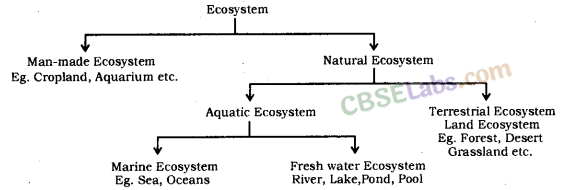
Components of Ecosystem: There are two components of an ecosystem : (i) biotic component and (ii) abiotic component.
1. Biotic component: It includes three types of organisms :
(a) Producers: All green plants, blue green algae can produce their food (Sugar and starch) from inorganic substance using light energy (Photosynthesis). Therefore, all green plants are called producers. They are also called autotrophs.
Planktons are very minute or microscopic organisms freely floating on the surface of water in a pond, lake, river or ocean. Planktons are of two types : Phytoplanktons and Zooplanktons.
The microscopic aquatic plants freely floating on the surface of water are called phytoplanktons.
The microscopic aquatic animals freely floating on water are called zooplanktons. The freely floating protozoa are an example of zooplankton.
(b) Consumers: They are organisms which consume other organisms or their products as their food. All animals belong to this category. The consumers depend upon producers for their food directly or indirectly. They get their food by eating other organisms or their products. For example, man, goat, deer, fish, lion, cow, buffalo, etc., are common consumers.
The consumers can be classified into the following types :
- Herbivores.
- Carnivores.
- Parasite.
- Omnivores.

(i) Herbivores: These are organisms (animals) which get their food by eating the producers (or plant) directly. Herbivores are also called first order consumers. Some common examples of herbivores are : deer, rabbit, rat, squirrel, goat, cattle, etc.
(ii) Carnivores: These are organisms (animals) which consume other animals. Therefore, carnivores feed on the flesh of herbivores. These are also called primary carnivores or second order consumers. Some common examples are snake, wild cat, jackal, frog, some birds, fishes, etc.
There are animals which prey upon primary carnivores. They are called second order consumers or third order consumers. For example, owl, peacock, tiger, lion, etc., are some second order carnivores and may be eaten by third order carnivores. The carnivores which are not preyed upon further are called top carnivores. For example, lion is a top carnivore.
(iii) Omnivores: The organisms which feed on both plants and animals are called omnivores. Human beings are common example of omnivores because they eat both plants (For example; pulses, grams, oilseeds, fruit, etc.) and animal products (milk, meat, egg, etc.).
(c) Decomposers: Fungi and bacteria which break down (decompose) the dead plants, animals complex compounds into the simpler one. The decomposers help in the replenishment of natural resources. These are also known as microorganism or saprotrophs. These are also called reducers.
Importance of Decomposers
- Decomposers help in disposing of the wastes and dead bodies of plants and animals. Therefore, they clean the environment and create space for a living of newer generations of organisms.
- The decomposers release minerals and other raw materials trapped in organic matter. These are picked up by plants. This also helps to maintain the fertility of soil.
- The decomposers produce some acids which are useful in solubilization of some minerals.
- Decomposers help in recycling the materials in the biosphere so that, the process of life may go on and on like an unending chain.
2. Abiotic Components: These are non-living components of an ecosystem. These include the physical environment.
- Edaphic factors like soil texture, topography, water, and air.
- Inorganic substances like carbon dioxide, nitrogen, oxygen, water, phosphorus, sodium, potassium, and calcium. These are involved in the cyclic of materials in the ecosystem.
- Organic compounds like proteins, carbohydrates, and lipids. These largely form the living body and link the abiotic and biotic components.
Climatic factors: These are sunlight temperature, pressure humidity, moisture, rainfall, etc. these factors affect the distribution of the organisms.
Functions of an Ecosystem
- Ecosystem indicates available solar energy and the efficiency of an ecosystem to trap the same.
- It gives information about the available essential minerals and their recycling periods.
- It provides knowledge about the web of interactions and inter-relationship among the various population as well as between the population and the abiotic environment.
- It helps human beings to know about conservation of resources, protection from pollution and inputs required for maximizing productivity.
- In the ecosystem, two processes of energy flow and biogeochemical cycles (nutrients movement) proceed side by side. The energy flow is unidirectional while the movement of nutrients is cyclic.
Food chain, Food web, Trophic levels. Flow of energy ten percent law, Depletion of the ozone layer, Biological magnification. Mode of waste disposal.
Food Chain: The sequence of living organisms in a community in which one organism consumes another organism to transfer food energy, is called a food chain.
A food chain is unidirection where transfer of energy takes place in only one direction.
OR
Food chain is sequential process which represents “who eats whom”.
OR
Food chain refers to an arrangement of different biotic groups in a sequence of energy transfer. These biotic groups are producer herbivores, carnivores.
For example, T1(Grass) → T2(Deer) → T3(Lion)
Examples of Food Chains: Simple food chain operating in a grass land or forest
Grass(Producer) → Deer(Herbivore) → Lion(Carnivore)
In this food chain, grass represent the producers (first tropic level). Grass synthesize their own food by the process of photosynthesis. Grass is eaten up by deer, which represents the herbivores or the primary consumers. Deer in turn is consumed by lion, the carnivores or the secondary consumers.
A food chain in grassland which has four steps is :
Grass(Producers) → Insect(Herbivores) → Frog(Carnivores) → Eagle(Secondary Carnivore)
Significance of Food Chains
- The study of food chains helps in understanding food relationships and interactions among the various organisms in an ecosystem. The food chains, transfer energy and materials between various living components of an ecosystem.
- The food chains transfer energy and materials between various living components in an ecosystem or biosphere.
- The food chains give dynamicity to an ecosystem or biosphere.
- The movement of toxic substances like pesticides, weedicides, etc., through food chains, can prove very harmful.
Food Web: The inter-connected food chains operating in an ecosystem which establish a network of relationship between various species, are called a food web.
In a food web, one organism may occupy a position in more than one food chain. An organism can obtain its food from different sources and in turn, may be eaten up by different types of organisms.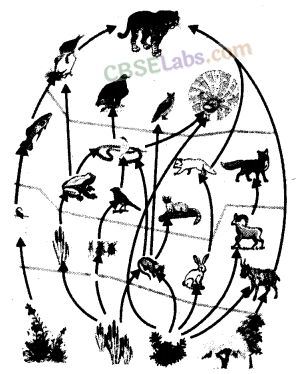
Trophic Levels: The various steps in the food chain at which the transfer of food (or energy) takes place is called trophic levels.
There is a gradual decrease in the amount of energy transfer from one trophic level to the next trophic level in a food chain.
So only 10% of energy is transferred to next trophic level while 90% of energy is used by present trophic level in its life processes.
The various trophic levels are given below :
- The plant or the producers constitute the first trophic level.
- The herbivores or primary consumers form the second trophic level.
- Carnivores or secondary consumers make up the third trophic level.
- Large carnivores or the tertiary consumers which feed upon the small carnivores constitute the fourth trophic level.
Flow Open Energy
Energy is used and conveyed from one trophic level to another in a food chain. This is called flow of energy. Green plants capture about 1% of the solar energy incident on the Earth through the biochemical process of photosynthesis. A part of this trapped energy is used by plants in performing their metabolic activities and some energy is released as heat into the atmosphere. The remaining energy is chemical energy stored in the plants as ‘carbohydrates’. When plants are eaten up by herbivores, the chemical energy stored in the plants is transferred to these animals. These animals (herbivores) utilize some of this energy for metabolic activities, some energy is “released as heat and the remaining energy is stored. The process of energy transferred is similarly repeated with carnivores and so on.
Ten percent law: Ten percent law states that only 10 percent of the energy entering a particular trophic level of organisms is available for transfer to the next higher trophic level.
For example, Suppose 1000 J of solar energy is received by green plants, then only 1% of solar energy available on earth is utilized by plants. So only 10 J (1% of 1000 J) is trapped by plants and the rest 990 J of energy is lost to the environment. So, plants utilizes only 10 J of energy. Next, only 10% of the 10 J energy of plant, that is, 1 J, is available to the herbivore animal while 9 J is lost to the environment. Again, just 10% of the 1 J of energy of herbivore animals is utilized by carnivore animals. Thus, carnivore animals have only 0.1 J of energy while 0.9 J is lost to the environment.
Environmental Problems: Changes in the environment affect us and our activities change the environment around us. This led to the slow degradation of the environment that arose many environmental problems. For Example; depletion of the Ozone Layer and waste disposal.
Depletion of Ozone Layer: Ozone (O3) layer is largely found in the stratosphere which is a part of our atmosphere from 12 km -50 km above sea level. This region is called ozonosphere. Ozone is deadly poisonous at the ground level.
Ozone is formed as a result of the following photochemical reaction.
Ozone layer is a protective blanket around earth which absorbs most of the harmful U.V. (Ultraviolet) radiation of the Sun, thus, protecting the living beings of the Earth from health hazards like skin cancer, cataract in eyes, weaken immune system, destruction of plants etc. The decline of Ozone layer thickness in Antarctica was first discovered in 1985 and was termed as OZONE HOLE.
Steps taken to limit damage of ozone layer: Excessive use of CFCs (Chloro Flouro Carbon) a synthetic, inert chemical. For example; Freon which are used as refrigerants and also in fire extinguishers caused Ozone depletion in the upper atmosphere. A single chlorine atom can destroys 1,00,000 Ozone molecules. U.N.E.P. (United Nation Environment Programme) did an excellent job in forging an agreement to freeze CFC production at 1986 levels (KYOTO Protocol) by all countries.
Biological Magnification: The increase in concentration of harmful chemical substances like pesticides in the body of living organisms at each trophic level of a food chain is called biological magnification.
Example:
Maximum concentration of such chemicals gets accumulated in human bodies.
Garbage Disposal: Industrialization and rise in demand of consumer goods have created a major problem in the form of wastes/garbage accumulation and its disposal especially in urban areas.
The disposal of waste should be done in a scientific way. There are different methods of waste disposal. The method to be used depends on the nature of the waste. Some of the important modes of waste disposal are :
- Incineration: Burning of waste on high temperature to form ash is called incineration. This process is carried out in an incinerator. Incineration is used to destroy household, chemical and biological wastes.
- Open dumping: A conventional method in which solid waste are dumped in selected areas of a town. It actually cause pollution
- Land fillings: Wastes are dumped in low living areas and are compacted by rolling with bulldozers
- Composting: Organic wastes are filled into a compost pit (2m × 1m × 1m). It is then covered with a thin layer of soil. After about three months the same garbage filled inside the pit changes into organic manure.
- Recycling: The solid wastes is broken down into its constituent simpler materials. These materials are then used to make new items. Even non-bio degradable solid wastes like plastic, metal can be recycled.
- Reuse: A very simple conventional technique of using an item again and again. For example; paper can be reused for making envelops, etc…
Environment: The combination of all the physical and biological conditions affecting the responses of living organisms is called environment.
Biodegradable wastes: The wastes which are broken down by the activity of micro¬organisms and enter into the biogeochemical cycle are known as biodegradable wastes.
Non-biodegradable wastes: The wastes which cannot be broken down by the enzymes produced by microorganisms into simpler and harmless products in nature are called non- biodegradable wastes.
Garbage: Domestic wastes including the kitchen waste are termed as garbage.
Incineration: Destruction of waste materials by burning at high temperature is called incineration.
Biotic Community: A group of various populations of organisms living in a region is called the biotic community.
Ecosystems: The self-contained and distinct functional unit capable of independent existence made by the interaction of living and non-living components is called an ecosystem.
Ecosystem component consists of two components- Abiotic and biotic
- Abiotic: Components consist of inorganic and organic substances and climatic factors.
- Biotic: Components consist of a living organism.
Autotrophs: Those organisms which can produce their own food are called autotrophs or producers. All green plants are producers.
Consumers: Those organisms which are unable to synthesise their food themselves and consume the food produced by producers or eat other organisms as food, are known as consumers.
Decomposers: Bacteria and fungi which break down the complex organic compounds present in the dead plants and animals and their products into simpler substances are known as decomposers.
Food Chain: A series of organisms in a community in which one organism consumes another organism to transfer food energy is called a food chain.
Characteristics:
- A food chain helps in understanding the food relationship and interactions among various organisms in an ecosystem.
- There is a progressive decline in the amount of energy available as we move from one trophic level to another in a food chain.
Trophic levels: Each step of the food chain is known as a trophic level. 10% of food taken by one trophic level is available for the next trophic level.
Food Web: The web formed by the interconnection of food-chains of the various trophic levels is called a food web.
Biomagnification: The increase in the concentration of the harmful chemicals in the body of an
organism per unit its mass at each successive trophic level in a food chain is known as biomagnification.
Ozone Depletion: The thinning of the ozone layer is called ozone depletion.
Ozone-depleting substances: Chlorofluorocarbons (CFCs), oxides of nitrogen, methane, carbon tetrachloride and chlorine are the ozone-depleting substances.
Four practices which can help in the protection of our environment:
- Disposal of wastes after separating them into biodegradable and non-biodegradable waste material.
- Use of unleaded petrol and alternate sources of energy, and keeping the engine properly tuned and serviced and the tyres inflated to the right pressure so that the vehicle runs efficiently.
- The use of gunny bags and paper bags in place of polythene/plastic bags.
- Activities such as gardening, rain-water harvesting and use of compost in place of fertilizers will help protect our environment from further damage.
Harmful effects of agricultural practices on the environment.
- Excessive use of fertilisers changes the chemistry of soil and kills useful microbes.
- Excessive use of non-biodegradable chemical pesticides leads to biological magnification.
- Extensive cropping causes loss of soil fertility.
- Excess use of groundwater for agriculture lowers the water table.
- Agricultural practices lead to some amount of damage to the natural ecosystem/habitat.
1. Environment: The physical, chemical and ‘ biological conditions of the region in which an organism lives is called its Environment. It includes air, light, soil, temperature, water and the presence or absence of other organisms, i.e., the conditions for development or growth.
The environment has three main components, viz :
- Physical surroundings [soil, air and water bodies]
- Living organisms [plants, animals, decomposers (bacteria and fungi)]
- Meteorological factors (or climatic factors) . [sunlight, temperature, rainfall, humidity, pressure and wind speed].
2. Physical environment: It is also called a abiotic or non-living environment. It includes :
- Soil, water bodies and air on the surface of the earth.
- Meteorological factors.
The physical environment is essential for :
- Supply of nutrient elements to the living beings.
- Providing space to the organisms for living.
- Controlling weather of a place.
3. Biotic (or biological) environment: It includes :
- Plants.
- Animals (including human beings).
- Decomposers (bacteria and.fungi).
Other important constituents of the biotic environment includes Kites and vultures as they feed on dead organisms and act as scavengers (cleansing agents) of the environment.
4. Ecosystem: A community of organisms, interacting with each other, plus the environment in which they
live and with which they also interact. The examples of the ecosystem are a pond; a desert; a forest; a lake; a river; a mountain; the sea.
All the above ecosystems are made up of two main components.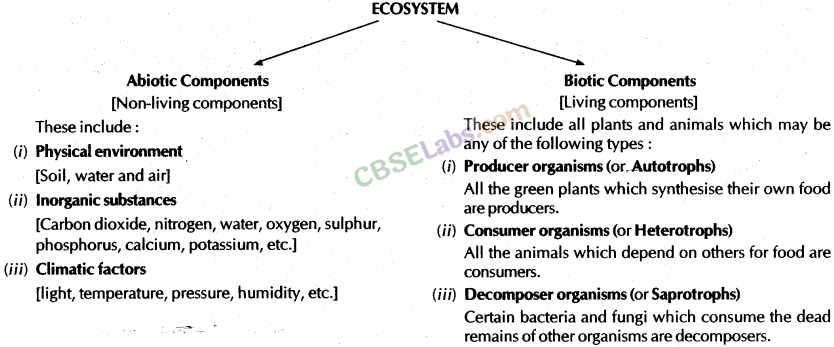
5. Autotrophs (Producers) and Heterotrophs (consumers):
6. Food chain: The sequence of living organisms in a . community in which one organism.e^ts other and is
itself eaten by another organism to transfer energy is called a food chain. It is also defined as, “chain of organisms, existing in any natural community, through which energy is transferred”.
7. Ozone layer : Ozone (O3) is a molecule formed by three atoms of oxygen unlike oxygen which is required for respiration by aerobic forms, ozone is a deadly poison. However, at the higher levels of the atmosphere,
ozone performs an essential function. It shields the surface of the earth from ultraviolet (UV) radiation from the Sun. This radiation is highly damaging to organisms, for example, it is known to cause skin cancer in human beings.
Ozone at the higher levels of the atmosphere is a product of UV radiation, acting on oxygen (O2) molecule. The higher energy UV radiations split apart some molecular
oxygen (O2) into free oxygen (O) atoms. These atoms then combine with the molecular oxygen to form ozone as shown:
Depletion of ozone layer: Ozone layer gets depleted – due to the use of chemicals called aerosol, spray propellants like chlorofluorocarbons. Depletion of ‘ ozone layer would cause skin cancer in men and animals and severe damage to the plants.
8. Biological magnification: It means accumulation of non-biodegradable chemicals (like pesticides) in the living organisms (like plants, animals, including man) in a food chain. “The increase in the concentration of harmful chemicals in the body of living organisms at each trophic level of a food chain is called biological magnification”.
9. Biodegradable wastes and Non-biodegradable wastes: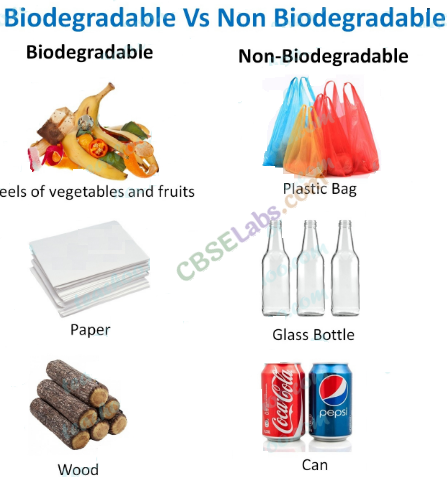
10. A generalised food chain:
11. Food web: A food web is a network of food chains which establish a network of relationships between various species. Food web showing 8 interlinked food chains.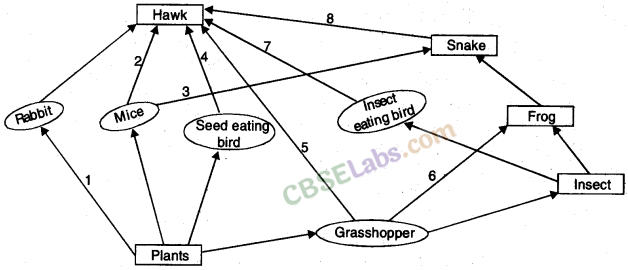

13. The flow of energy between various components of the environment:
- Green plants capture about 1 % of the energy and convert it into food energy.
- About f % of the food eaten is turned into the body of an organism and made available for the next level of consumers.
- About 10% of organic matter is present at each step and reaches the next level of consumers.
- Since so little energy is available for the next level of consumers, food chains generally consist of only three or four steps. The loss of energy at each step is so great that very little usable energy remains after four trophic levels.
- There are generally a greater number of individuals at the lower trophic levels of an ecosystem, the greatest number is of the producers.
NCERT Exemplar Class 10 Science Chapter 15 Our Environment
Short Answer Questions
Question 1. Why is improper disposal of waste a curse to environment?
Answer. Improper disposal of waste is a curse to environment because it pollutes the environment, air, water, soil and cause harmful effects on living organisms.
For example, passage of sewage into water body cause eutrophication, killing of animals and source of water-borne pathogens.
Question 2. Write the common food chain of a pond ecosystem.
Answer. Phytoplanktons and aquatic plants ———–> Zooplanktons and small aquatic animals and larvae, insects, etc. ———–> Fish ———–>Bird.
Question 3. What are the advantages of cloth bags over plastic bags during shopping?
Answer. Advantages of cloth bags:
- They are made of biodegradable material.
- They can be recycled and reused.
- They do not pollute the environment.
- They are strong and more durable than plastic bags.
- They are capable of carrying more things.
- They are washable.
Question 4. Why are crop fields known as artificial ecosystems?
Answer. Crop fields are known as artificial ecosystems because they are man-made and some biotic and abiotic components are maintained, nourished and reaped by human beings.
Question 5. We do not clean ponds or lakes, but an aquarium needs to be cleaned. Why?
Answer. An aquarium is an artificial and incomplete ecosystem compared to pond or lakes which are natural, self-sustaining and complete ecosystem where there is a perfect recycling of materials. Therefore, it needs to be cleaned.
Long Answer Questions
Question 6. Suggest any four activities in daily life which are eco-friendly.
Answer.
- Use of cloth bags instead of plastic bags.
- Gardening.
- Harvesting of rainwater and preventing wastage of resources.
- Use of compost.
Question 7. Indicate the flow of energy in an ecosystem. Why is it unidirectional ? Justify.
Answer. The flow of energy generally is as follows:
Sun ———>Producers ———> Herbivores ———> Carnivores
Since, flow is progressively from one trophic level to another and does not revert back, it is said to be unidirectional, i.e. from sun to plants, plants to animals,
animals to other animals and organic remains to decomposers. Thus, the available energy decreases in the higher trophic levels making impossible for energy flow in reverse direction.
Question 8. Name the wastes which are generated in your house daily. What measures would you take for their disposal?
Answer. The wastes generated daily are kitchen wastes, paper wastes like newspapers, bags, envelopes, plastic bags, vegetable and fruit peels, dust and empty cartons, etc. Measures for disposal are:
- Separation of biodegradable and non-biodegradable recyclable and non-recyclable wastes.
- Safe disposal of plastic bags.
- Preparation of compost from kitchen wastes for home garden or given to waste collector for disposal.
- Paper waste can be given for recycling.
Question 9. Explain some harmful effects of agricultural practices on the environ-ment.
Answer. Some harmful effects of agricultural practices on the environment are as follows:
- Use of fertilisers change the chemistry of soil and kills useful microbes.
- Use of non-biodegradable pesticides leads to bio-magnification.
- Extensive cropping causes loss of soil fertility.
- Use of ground water for agriculture ‘ has resulted in lowering water table,
- Natural ecosystems and habitat have been damaged during clearing of land for agriculture.
NCERT Solutions for Class 10 Science All Subject NCERT Solutions
- Chapter 1 Chemical Reactions and Equations
- Chapter 2 Acids, Bases and Salts
- Chapter 3 Metals and Non-metals
- Chapter 4 Carbon and Its Compounds
- Chapter 5 Periodic Classification of Elements
- Chapter 6 Life Processes
- Chapter 7 Control and Coordination
- Chapter 8 How do Organisms Reproduce?
- Chapter 9 Heredity and Evolution
- Chapter 10 Light Reflection and Refraction
- Chapter 11 Human Eye and Colourful World
- Chapter 12 Electricity
- Chapter 13 Magnetic Effects of Electric Current
- Chapter 14 Sources of Energy
- Chapter 15 Our Environment
- Chapter 16 Management of Natural Resources
.png)
.png)